Guinea Fowl and Tick Control
Air Date: Week of July 10, 2020
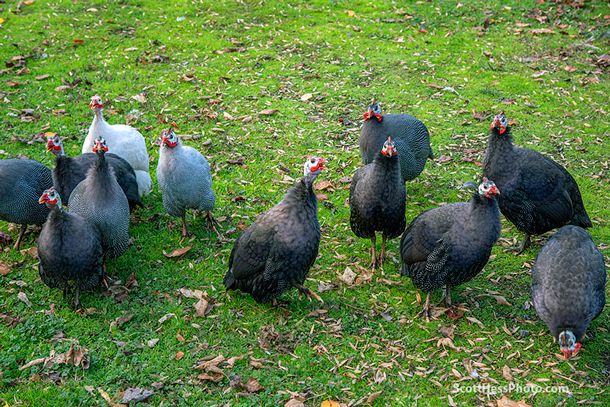
Guinea fowl like to forage for ticks, mosquitoes, fleas, beetles, spiders, and more. (Photo: Scott Hess, Flickr, CC BY-NC 2.0)
Deer ticks can carry Lyme disease, a debilitating disease if left untreated, and one that’s becoming more common thanks to the warming climate. Now some homeowners in the thick of tick country are turning to guinea fowl to control ticks. Living on Earth’s Jenni Doering reports from Exeter, New Hampshire about one family’s experience with these tick-eating machines.
Transcript
CURWOOD: It’s the height of tick season and in the eastern U.S., beware of the blacklegged or deer tick that can carry Lyme disease, which if left untreated, can spread to joints, the heart, and the nervous system. And research shows climate change is making it even more common. One US study found that boosting average temperatures by 2 degrees Celsius could increase Lyme disease cases by 20 percent. Luckily, there are proven ways to reduce your risk. Wear long sleeved clothing, use repellents, and do a thorough tick check after you’ve been walking outside in the woods, or meadows where ticks can hide. And Living on Earth’s Jenni Doering reports from Exeter, New Hampshire about another way to combat ticks in your back yard.
[FOREST SOUNDS]
DOERING: Suzy and Hazel Koff live an enchanted childhood.
On a warm July day, the 6 and 3-year-olds run through the sun-dappled forest in their New Hampshire backyard.
[SOUNDS OF KIDS RUNNING AND PLAYING]
SUZY: Okay, come out!... No, no, no, no, no!
DOERING: Their mother, Sarah, says this is how they spend their summer.
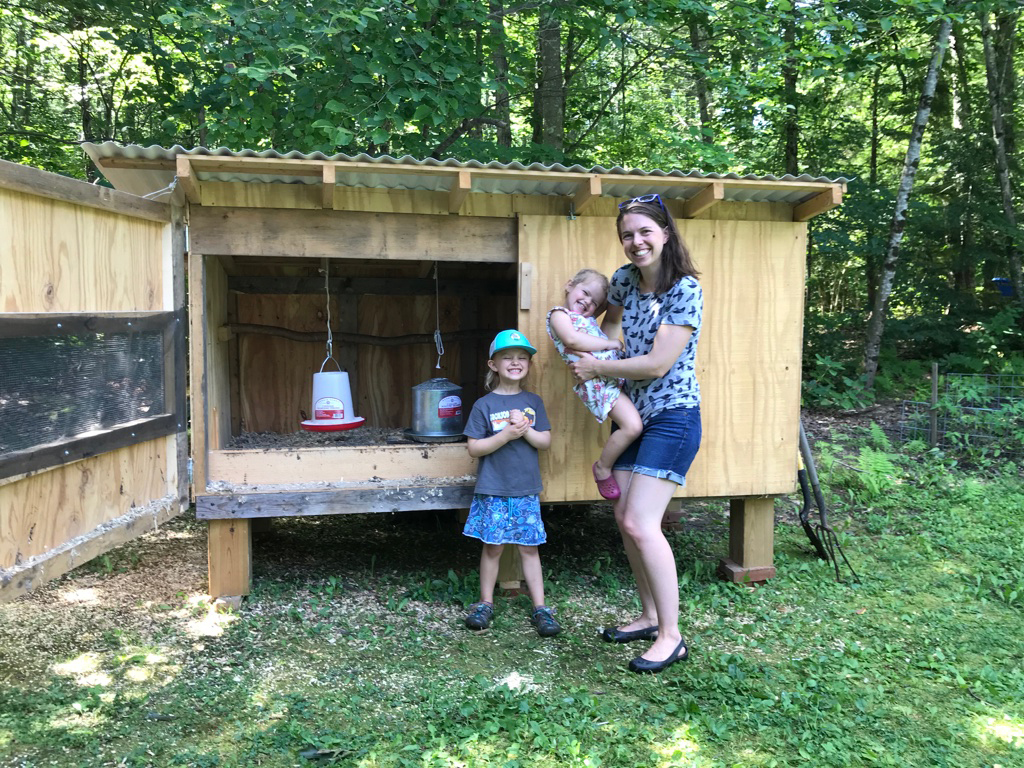
Sarah Koff with daughters Suzy, 6, and Hazel, 3, in front of the guinea fowl coop in their backyard. (Photo: Jenni Doering)
KOFF: We love going outside playing in the woods. We have this great big yard that they play in and we have a sandbox out here and slack line and all sorts of things; we like to make fairy houses, and we like to garden together. So, yeah we’re outside pretty much every day.
DOERING: But in the Northeast, where there are woods, there are ticks. A lot of them.
KOFF: I was so, just, overwhelmed by the ticks in our yard. I’m a big gardener and my daughters – I just feel like it’s really important for them to spend as much of their time outside as possible. And you know, we live in the woods. And so in April and May, they were just coming in with ticks every day on them – and my husband was and I was – and it was just getting too much; I was so overwhelmed and I just, I’m such a big gardener, there’s no way I was willing to spray anything on the lawn or use any sort of chemicals at all, so I thought I would try this biological control…
DOERING: Enter the guinea fowl --
[GUINEA FOWL CALLING]
DOERING: Native to Africa, guineas are rather awkward, football-shaped birds with a tiny head, and a voracious appetite for ticks. And unlike chickens, guinea fowl won’t peck at your garden greens. So Sarah decided to give them a try.
KOFF: Yeah, I just went on Craigslist and I pretty easily found… there were actually a lot of different ads for people selling guineas but we wanted a certain amount and we wanted them to be babies, so it was a perfect guy who had them and raised them and told me a lot about them.
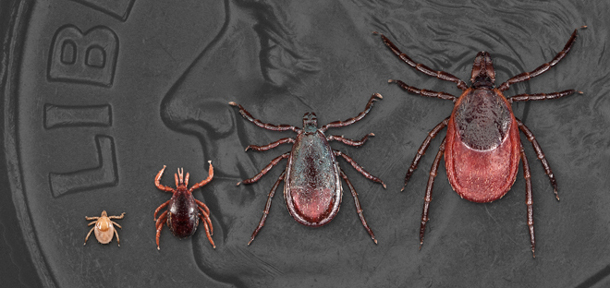
From left, the larvae, nymph, adult male and adult female forms of the blacklegged or deer tick, which can carry Lyme disease. (Photo: CDC)
[GUINEA FOWL CALLING]
DOERING: The Craigslist guineas got right to work.
KOFF: As soon as we started letting them out they were immediately interested in pecking, pecking and pecking. So yeah, they were just sort of tearing up all the bugs! [LAUGHS]
DOERING: Sarah and the kids showed me to a cute little wooden coop with a tin roof, and a single, black and white speckled guinea fowl inside. Sarah unlatched the door and with Hazel’s help, tried to coax the timid bird outside.
[DOOR LATCH SOUND]
KOFF: Hello?
HAZEL: Guinea, you can come out now! What are they doing in there?! [LAUGHS]
DOERING: Is it pretty scared?
KOFF: Well, you know what, they’ve always been scared of us. They’ve always been scared. They’re not, they’re not pets.
HAZEL: Yeah…
KOFF: They’re sort of wild animals that you just have. – There you go.
HAZEL: Ah ha! That’s it.
DOERING: The guinea sprints down the coop’s ramp – and straight into the forest.
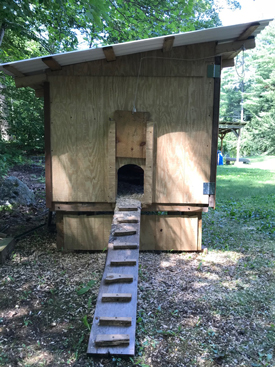
The Koffs’ coop keeps the guinea fowl safe from predators at nighttime, but they’re vulnerable during the daytime when they roam around eating ticks and other bugs. (Photo: Jenni Doering)
KOFF: I don’t think he’ll go very far. He doesn’t usually go very far. Yes, there he is. And we could also give him some scratch. You want to give him some scratch?
[BAG RUSTLING, FEED SPRINKLING ON GROUND]
SUZY: Hey, come on and eat it! You’re not eating it!
DOERING: Why just the one?
KOFF: Well, we used to have eight, but then earlier this week, unfortunately, seven of them disappeared; and we don’t know what happened but we think that they were either killed or ran away; were definitely spooked by some predator, because we did find one dead hen, so.. yeah it’s really sad.
[GUINEA CALLING]
DOERING: Finally we spot the elusive guinea in a neighbor’s yard.
KOFF: Oh. There she is, right there, do you see it?
HAZEL: Where is she?
KOFF: Under the bushes.
DOERING: Before the guinea fowl massacre, Sarah says she noticed a dramatic decline in the number of ticks on her family.

Guinea fowl are native to Africa. Above, a wild guinea fowl in Kenya’s Maasai Mara National Reserve. (Photo: Marc, Flickr, CC BY-NC-ND 2.0)
KOFF: I haven’t seen any ticks on the kids since we’ve let the guineas go roam around. And my husband I think has found one on himself so far.
DOERING: A small 1992 study on Long Island backs up Sarah’s observation.
Researchers placed guinea fowl into tick-infested areas and found that they significantly reduced the adult tick population within the enclosures. But Howard Ginsberg, a research ecologist with the Department of Interior, points out a problem with timing.
GINSBERG: Most people get Lyme disease during June and July when the nymphs are out, and the nymphs are in the woods. The adults, which are the stage that’s targeted by these birds, is out in the fall and spring, out in open areas like people’s lawns; and some people get Lyme disease that way but not most people. So there may be some effect, but in general it’s not going to solve a disease problem.
DOERING: In fact, another study in New York State from 2004 found that where guinea fowl were allowed to range freely, ticks in the nymph stage weren’t reduced, so the Lyme disease risk remained high.
Still, a single female deer tick can lay as many as 2,000 eggs, so removing adult ticks does appear to reduce local Lyme disease risk overall. Fortunately, even if a tick latches on to you, Ginsberg says time is on your side.
GINSBERG: Lyme disease, that bacterium requires something like 24 to 48 hours with tick attachment before it’s transmitted. So if you do a check every day when you get back from the woods and remove ticks, you have eliminated the possibility of Lyme disease fairly substantially.
DOERING: And if you do find a tick embedded in your epidermis…
GINSBERG: The best way to remove a tick is to just take fine tweezers, just grab as close to the skin line as possible, and slowly pull it straight out.
DOERING: Then, take some rubbing alcohol and clean the bite thoroughly.
And get that tick safely out of your life by flushing it down the toilet.
[GUINEA FOWL CALLING]
DOERING: So, does Sarah plan to replenish the flock?
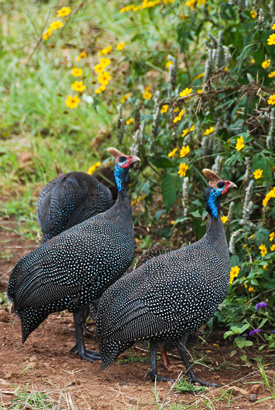
Guinea fowl target adult ticks, not the nymphs, which are more likely to infect a human with Lyme disease. (Photo: Chris.Murphy, Flickr, CC BY-ND 2.0)
KOFF: So we are feeling a little bit unsure of how to proceed with just one right now. They’re very social creatures and they really do need to be with others, and so I’m actually in the middle of deciding whether we bring in some more, maybe some babies, for this one to raise; or do we try to re-home this guinea to a place that has guineas already?
DOERING: No matter what they decide, Sarah says the ticks won’t stop her and the kids from getting outside.
KOFF: Kids need to be just exposed to nature as much as possible and we’re so lucky to be living in a place that – we have the woods right in our backyard; we have a trail that we can connect to from our backyard. There are so many studies that show that it relieves anxiety in kids; it just makes them be more independent, more creative, have a bigger imagination, and just more comfortable in the outdoors, which is -- I mean, it’s therapy. But I also just check them for ticks every day and I try not to be anxious about it, because there’s not too much I can do about it other than check them thoroughly.
DOERING: With a thorough head-to-toe check, even the smallest ticks can be found before they pose a Lyme disease risk. For Living on Earth, I’m Jenni Doering in Exeter, New Hampshire.
[GUINEA FOWL CALLING]
Links
1992 study about guinea fowl reducing adult deer ticks
2004 study that found that guinea fowl do not reduce tick nymphs
Living on Earth wants to hear from you!
Living on Earth
62 Calef Highway, Suite 212
Lee, NH 03861
Telephone: 617-287-4121
E-mail: comments@loe.org
Newsletter [Click here]
Donate to Living on Earth!
Living on Earth is an independent media program and relies entirely on contributions from listeners and institutions supporting public service. Please donate now to preserve an independent environmental voice.
NewsletterLiving on Earth offers a weekly delivery of the show's rundown to your mailbox. Sign up for our newsletter today!
 Sailors For The Sea: Be the change you want to sea.
Sailors For The Sea: Be the change you want to sea.
 The Grantham Foundation for the Protection of the Environment: Committed to protecting and improving the health of the global environment.
The Grantham Foundation for the Protection of the Environment: Committed to protecting and improving the health of the global environment.
 Contribute to Living on Earth and receive, as our gift to you, an archival print of one of Mark Seth Lender's extraordinary wildlife photographs. Follow the link to see Mark's current collection of photographs.
Contribute to Living on Earth and receive, as our gift to you, an archival print of one of Mark Seth Lender's extraordinary wildlife photographs. Follow the link to see Mark's current collection of photographs.
 Buy a signed copy of Mark Seth Lender's book Smeagull the Seagull & support Living on Earth
Buy a signed copy of Mark Seth Lender's book Smeagull the Seagull & support Living on Earth

